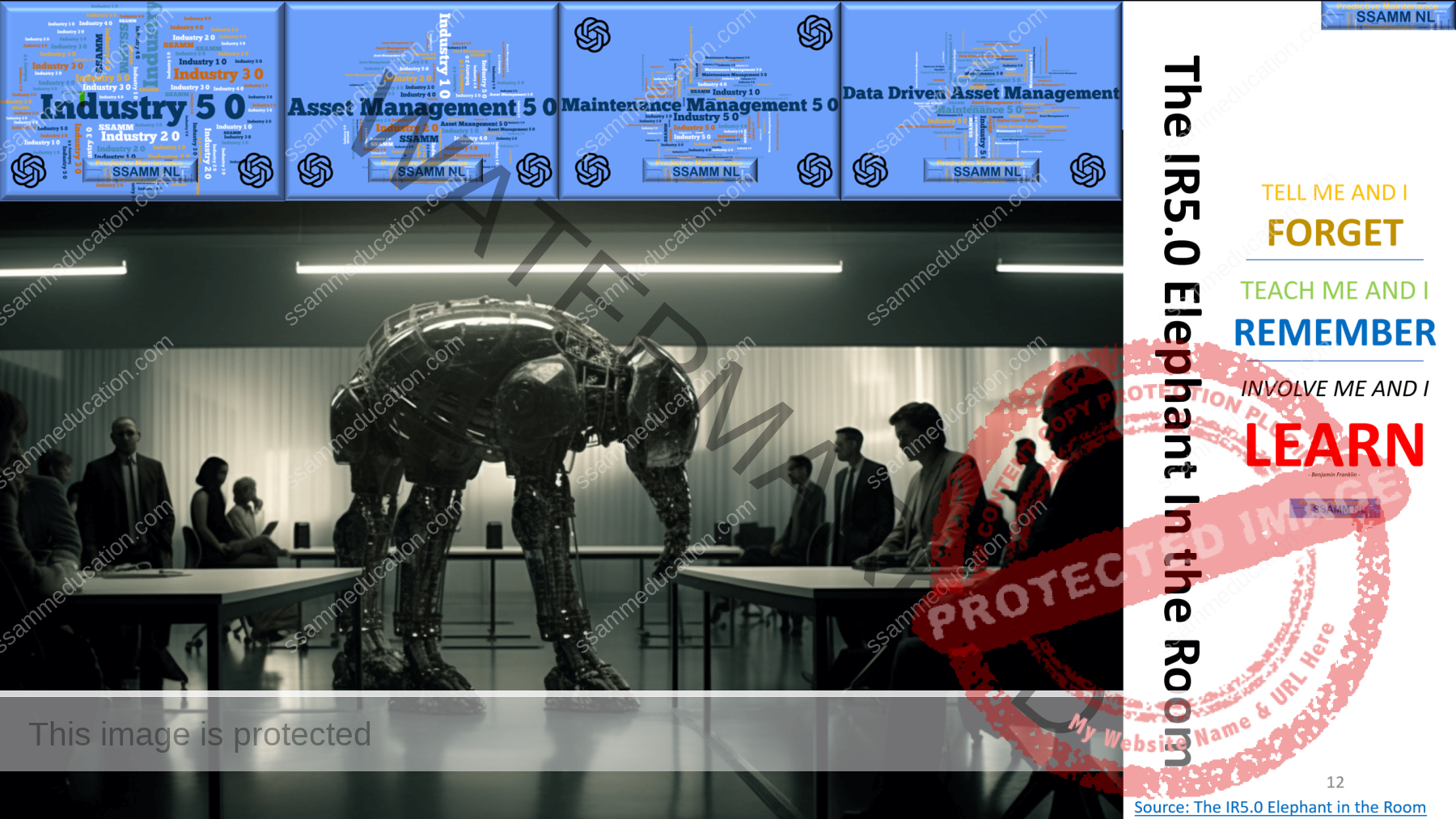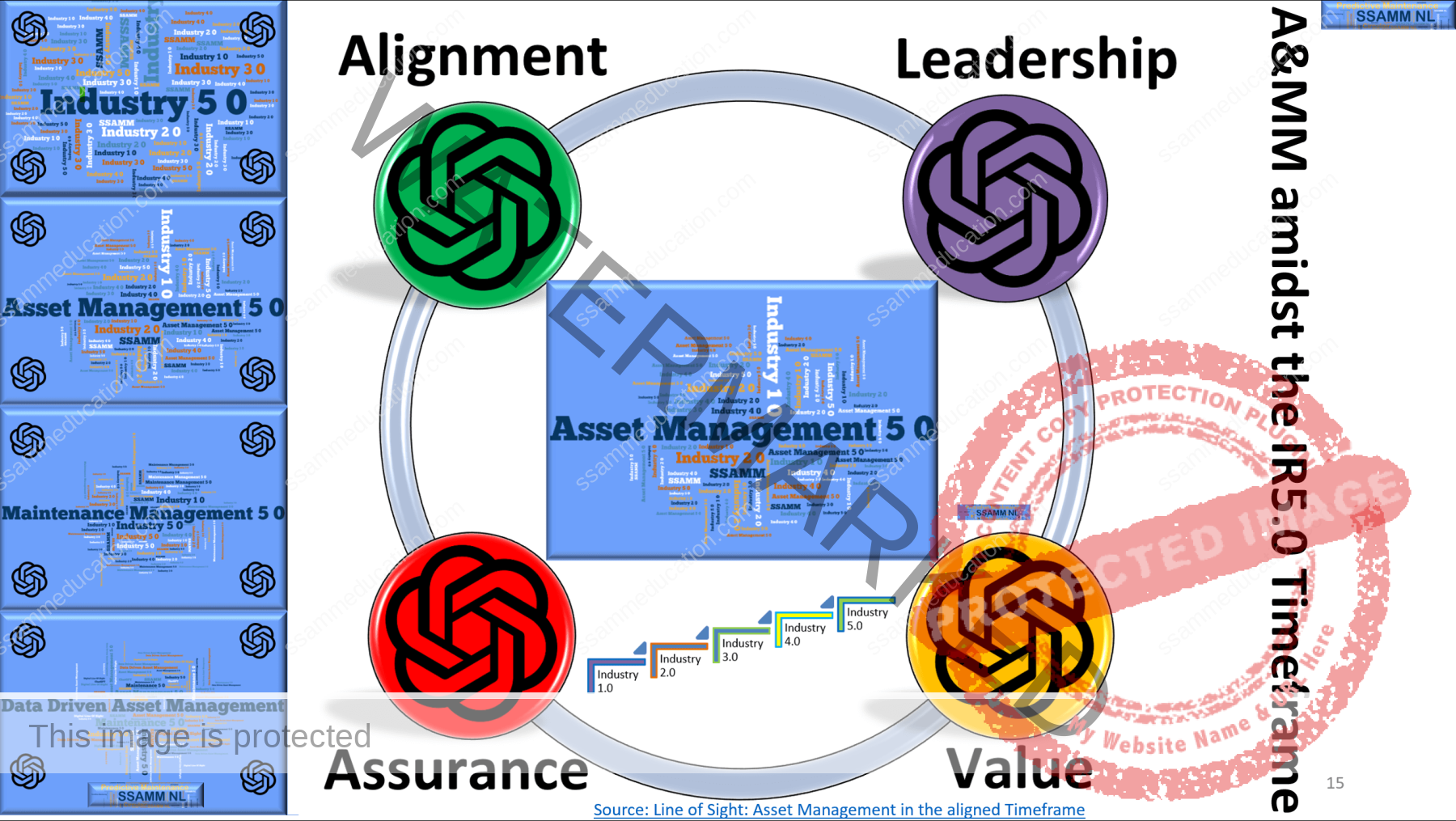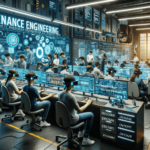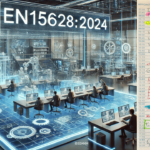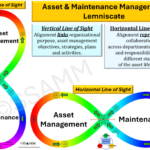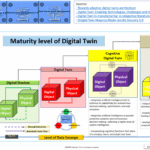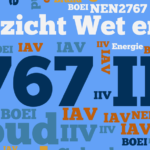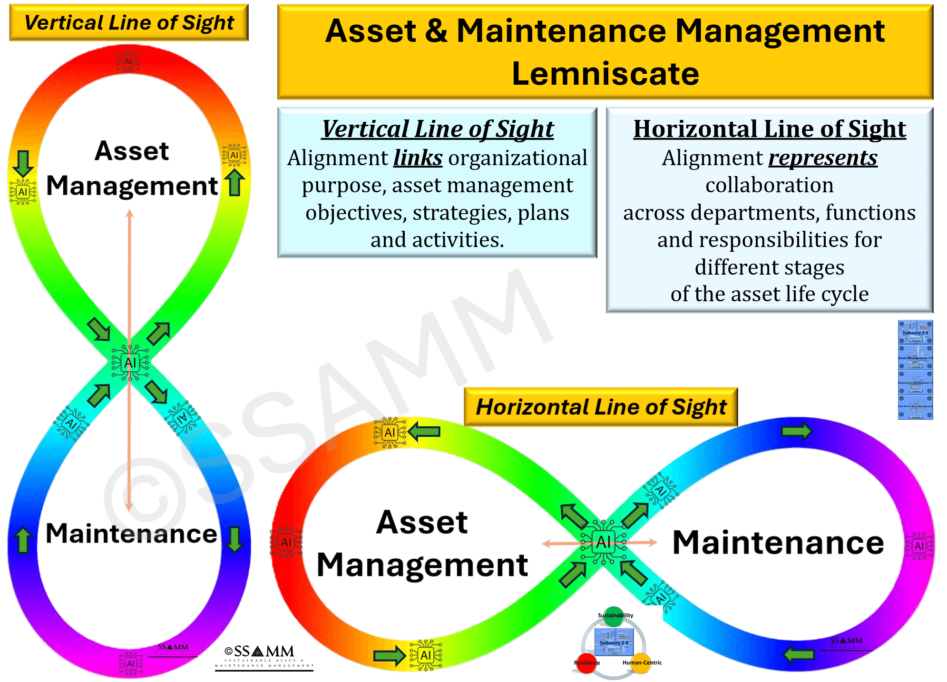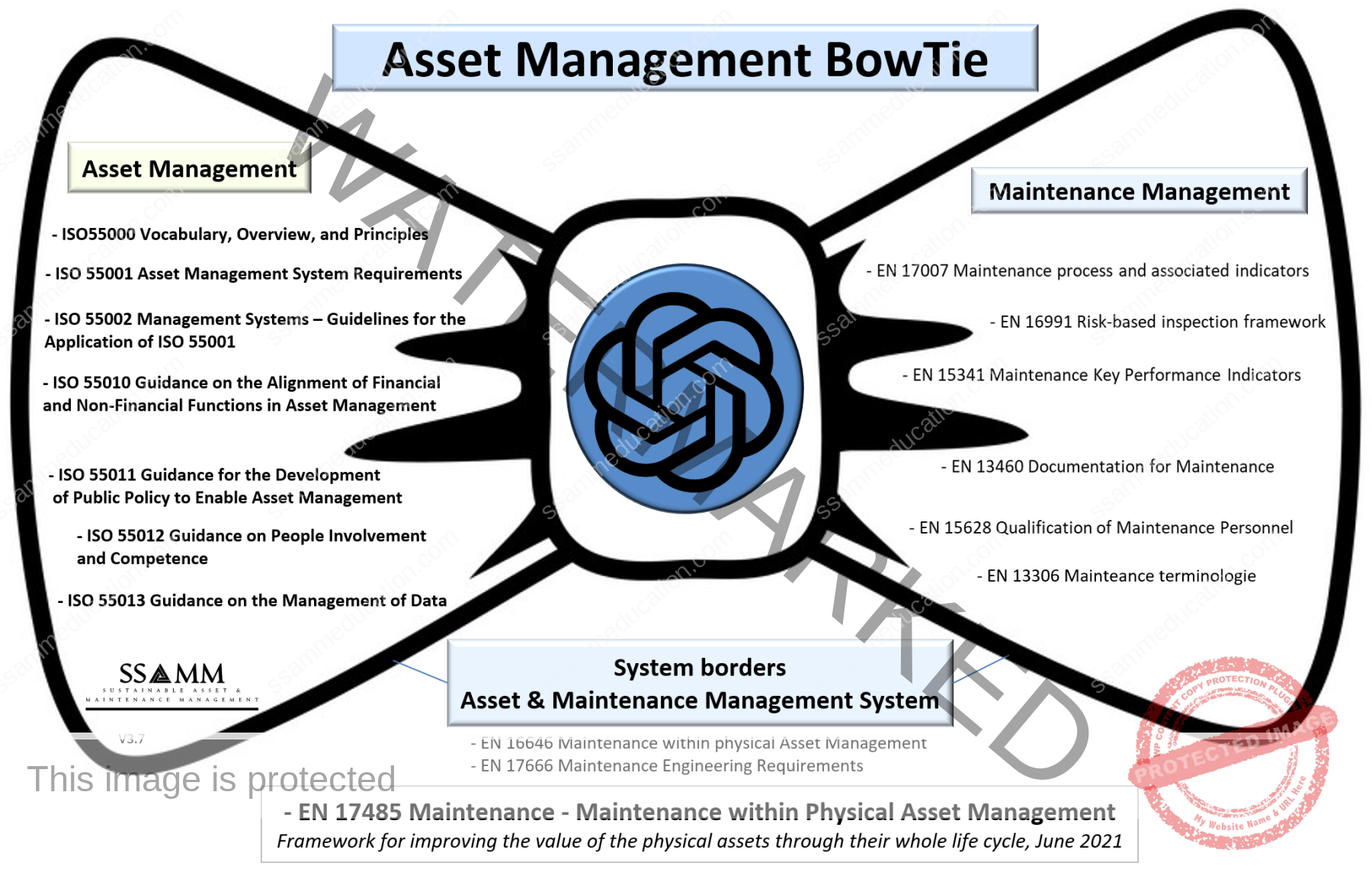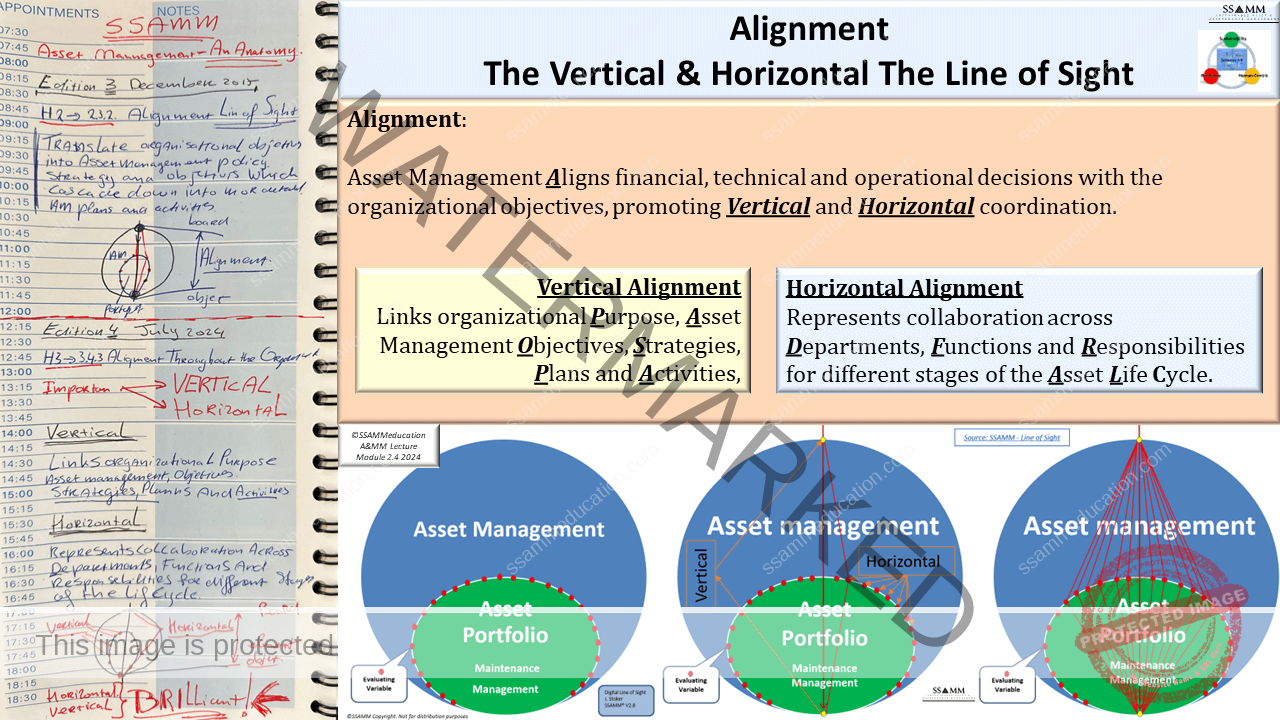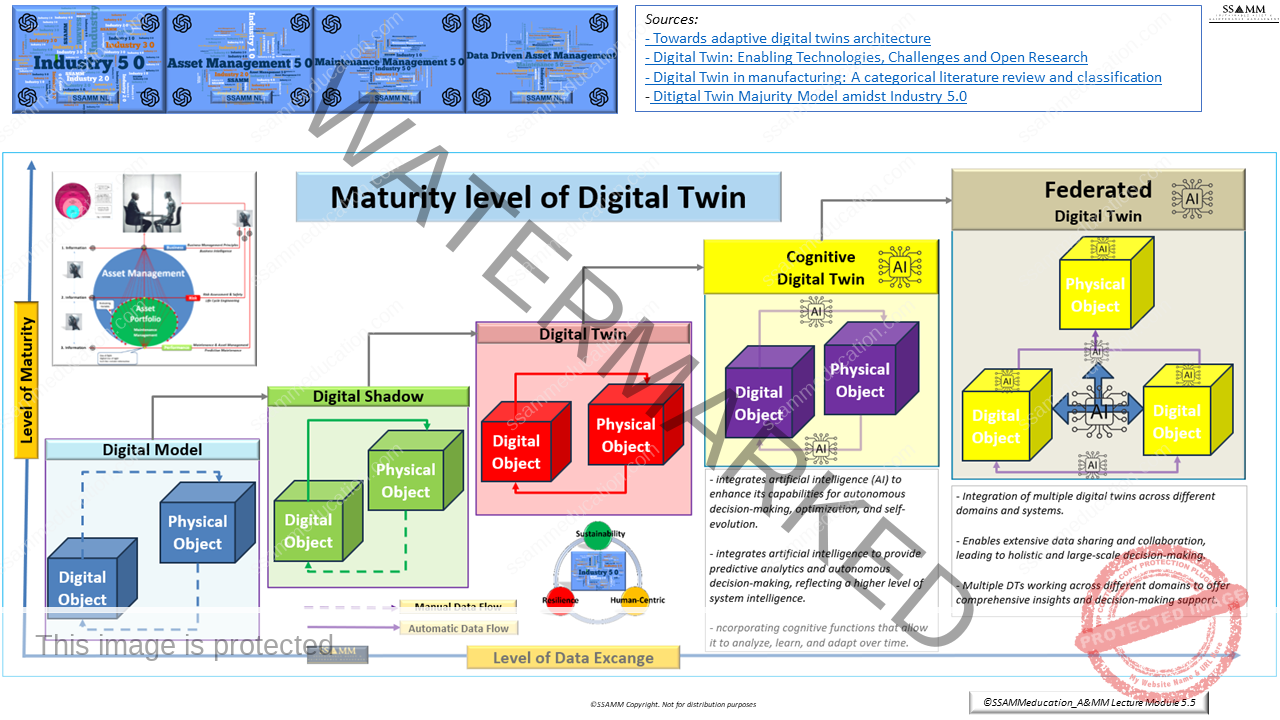The landscape of Asset & Maintenance Management is continuously evolving, driven by advancements in technology and changing organizational needs. Central to this evolution is the alignment of organizational strategies with operational activities, ensuring that every level of the organization works cohesively towards common goals. ISO55000:2024 outlines the principles of this alignment, often visualized through the analogy of the lemniscate (∞), or figure-eight symbol. This analogy, known as the “line of sight,” integrates vertical and horizontal alignments, creating a comprehensive framework for effective asset and maintenance management.
Countdown SSAMM Academy Module 1
Explore the SSAMM Academy Asset Management and Maintenance Management courses.
Click Here for the Smart information page
Author: Ing. Jan Stoker MSc. MEng. Follow Jan Stoker
1. Lemniscate Cornerstones IAM Anatomy, ISO55000:2024, EFNMS BoK, and The AM-Bowtie
ISO55000:2024 (Click here for full Article), particularly paragraph 4.2.3, reinforces this by highlighting the necessity of aligning financial, technical, and operational decisions with organizational objectives, promoting both vertical and horizontal coordination.
The EFNMS Body of Knowledge (BoK) underscores the importance of maintenance in preventing failures, restoring items, and mitigating unavailability. It emphasizes that maintenance involves technical, administrative, and managerial actions, requiring precise knowledge and skills. AI enhances these actions by providing predictive analytics and decision support systems, ensuring that maintenance activities are timely and effective.
This framework supports a normative understanding of how maintenance actions integrate with broader asset management strategies to optimize value creation and ensure reliability and sustainability. AI systems can enhance risk management by predicting potential failures and optimizing maintenance schedules, while Industry 5.0 principles ensure these systems support human operators effectively.
ISO550XX:2024 Deepening The Subject SAM, First EditionRespond or give your feedback
Vertical alignment connects an organization’s strategic objectives with its operational activities, ensuring that directives flow seamlessly from senior management to operational levels, translating high-level goals into actionable plans.
This alignment is crucial for maintaining coherence between the organization’s vision and its day-to-day operations. Feedback from operational activities back to senior management is essential for grounding these strategies in real-world realities, emphasizing the importance of continuous, bi-directional communication.
In the context of Industry 5.0, vertical alignment is further enhanced through human-centric approaches and advanced technologies. AI plays a pivotal role by facilitating real-time data analysis and predictive maintenance, ensuring that operational feedback is both accurate and timely. This integration enables more informed and effective strategic decisions, bridging the gap between high-level objectives and daily operations.
Horizontal alignment involves the integration and coordination across various departments and specialists within an organization.
This alignment requires collaborative efforts to break down silos and ensure that all parts of the organization work towards common objectives. By integrating diverse professional insights, horizontal alignment enhances decision-making and promotes continuous interaction and cooperation.
Industry 5.0 emphasizes the collaboration between humans and intelligent machines. AI systems facilitate cross-departmental communication and coordination by providing a unified platform for data sharing and process optimization.
This technological integration ensures a seamless flow of information and activities across the organization, aligning every department with the overall strategic goals.
1.3 The Full Lemniscate: Holistic Alignment
This continuous flow symbolizes ongoing improvement and adaptability, while the balance between the loops highlights the need to manage both dimensions together for optimal performance.
Incorporating Industry 5.0 and AI into this model ensures that technological advancements are leveraged to support both vertical and horizontal alignments.
AI-driven analytics can identify trends and insights that inform strategic planning and operational adjustments, while human-centric design principles ensure that technology enhances rather than replaces human capabilities.
2. The Horizontal & Vertical line of sight: Deepening the subject
This chapter explores these concepts comprehensively, with references to ISO55001:2024, ISO55002:2024, ISO55010:2024, and ISO55013:2024, as well as European standards like EN15628:2024, EN17007, and EN17485, highlighting their relevance in the Industry 5.0 landscape.
2.1 The Vertical Line of Sight: Strategic Alignment Across Levels
The Vertical Line of Sight connects an organization’s strategic objectives with its operational actions, ensuring that decisions made at the executive level cascade effectively down to the workforce. This dimension also incorporates feedback mechanisms, creating a dynamic loop that fosters continuous improvement and adaptability across the organization.
Click to enlarge
2.1.1 Strategic Governance and Policy Frameworks
At the top of the vertical alignment lies strategic governance, spearheaded by the Asset Manager. Guided by ISO55000:2024, the Asset Manager defines organizational objectives, aligning them with stakeholder expectations and sustainability priorities. EN17485 emphasizes the importance of establishing governance structures that provide clarity on responsibilities, policies, and strategic directives. This ensures a cohesive direction across all organizational levels, forming the foundation for effective asset management.
2.1.2 Translating Strategy into Operational Actions
2.1.3 Feedback Loops for Continuous Improvement
Feedback mechanisms are vital for maintaining the integrity of the Vertical Line of Sight. As per ISO55010:2024, operational data must be captured and analyzed to inform strategic refinements. The Maintenance Supervisor plays a key role in this process, providing actionable insights from day-to-day operations. These insights ensure that strategies remain relevant and responsive, aligning with Industry 5.0’s emphasis on agility and continuous learning.
2.1.4 Technology as a Catalyst for Vertical Alignment
Emerging technologies such as Digital Twins, IoT-enabled devices, and AI analytics enhance the Vertical Line of Sight by providing real-time visibility into asset performance. ISO55012:2024 advocates for the integration of these technologies into the AMS, enabling data-driven decision-making. By ensuring that strategic and operational teams access the same data, organizations can bridge gaps and improve alignment, fostering resilience and efficiency.
Full Digital Twin Article
2.2 The Horizontal Line of Sight: Interdepartmental Synergy
While the Vertical Line of Sight aligns strategy with operations, the Horizontal Line of Sight fosters collaboration across departments. This dimension is crucial for breaking down silos, ensuring that all functions work together toward shared objectives. By promoting interdepartmental synergy, the Horizontal Line of Sight enhances decision-making, resource optimization, and innovation.
Click to enlarge
2.2.1 Interdepartmental Collaboration for Shared Goals
The Horizontal Line of Sight unites diverse functions such as maintenance, finance, operations, and sustainability under a common framework. ISO 55002:2024 and EN17666 emphasize the need for effective communication and shared accountability to achieve asset management objectives. This collaboration ensures that each department’s actions complement rather than conflict with one another, creating a cohesive operational environment.
2.2.2 Data Sharing and Integrated Insights
Seamless data sharing is the cornerstone of horizontal alignment. In the Industry 5.0 context, technologies such as IoT sensors, predictive analytics, and cloud-based platforms facilitate real-time data exchange. ISO 55013:2024 stresses the importance of treating data as a strategic asset, advocating for robust governance frameworks to ensure its accuracy and accessibility. Maintenance Engineers and Asset Managers can leverage this data to optimize interventions, enhance reliability, and inform long-term planning.
2.2.3 Enhancing Maintainability and Lifecycle Efficiency
Horizontal collaboration is essential for improving maintainability, a critical aspect highlighted in ISO 55001:2024 and EN17007. Maintenance Supervisors work closely with design, procurement, and production teams to ensure that maintainability considerations are integrated into asset planning. This proactive approach reduces lifecycle costs, enhances performance, and supports sustainability objectives, aligning with ISO 55011:2024’s focus on long-term value creation.
2.2.4 Driving Innovation and Sustainability
The Horizontal Line of Sight also fosters innovation by integrating diverse perspectives. Collaboration between Maintenance Engineers, Asset Managers, and sustainability teams leads to the development of cutting-edge solutions such as predictive maintenance and energy-efficient designs. ISO 55000:2024 underscores the importance of sustainability, which is best achieved through a united, cross-functional approach. This alignment enables organizations to achieve their environmental, social, and economic goals in a holistic manner.
2.3 Integrating Vertical and Horizontal Dimensions for Holistic Alignment
The integration of the Vertical and Horizontal Lines of Sight creates a comprehensive framework for asset management. This multidimensional alignment ensures that strategic objectives are effectively translated into operational actions while fostering interdepartmental collaboration.
2.3.1 Synergizing Strategic and Operational Goals
The integration of vertical and horizontal dimensions ensures that all organizational activities are aligned with overarching strategic goals. ISO 55001:2024 and ISO 55010:2024 advocate for this synergy, emphasizing that both dimensions must work in tandem to achieve efficiency, adaptability, and resilience.
2.3.2 Leveraging Technology for Unified Alignment
Technologies such as Digital Twins, advanced analytics, and AI serve as enablers for integrating vertical and horizontal dimensions. As outlined in ISO55012:2024, these tools provide a unified data platform that facilitates collaboration and informed decision-making.
By leveraging these technologies, organizations can bridge gaps between strategy and execution, ensuring cohesive alignment.
2.3.3 Supporting Organizational Adaptability
The integration of the two dimensions also enhances organizational adaptability, a key tenet of Industry 5.0. By aligning strategy with interdepartmental collaboration, organizations can respond proactively to changes in market demands, technological advancements, or regulatory requirements. ISO 55011:2024 highlights the importance of adaptability in maintaining long-term value creation.
2.3.4 Enabling Value Creation Across the Asset Lifecycle
Ultimately, the integration of vertical and horizontal alignments ensures value creation throughout the asset lifecycle. ISO 55013:2024 emphasizes that aligning data assets with broader organizational goals enables better decision-making, resource optimization, and sustainability. This holistic approach drives resilience, innovation, and long-term success.
Wrap up, the Horizontal and Vertical Lines of Sight are indispensable for modern asset management. Together, they provide a robust framework for aligning strategic goals with operational execution while fostering interdepartmental collaboration. By integrating these dimensions and leveraging the guidance of the ISO 55000 series (2024) and related standards, organizations can navigate the complexities of Industry 5.0, ensuring efficiency, sustainability, and innovation throughout the asset lifecycle.
3. Industry 5.0: Human-Centric, Resilience, and Sustainability
Industry 5.0 represents the next evolutionary step in industrial and technological development, building on the principles established by Industry 4.0. While Industry 4.0 emphasized automation, interconnectivity, and the integration of cyber-physical systems, Industry 5.0 focuses on the harmonization between human capabilities and advanced technologies. It prioritizes creating sustainable, resilient, and human-centric industrial systems that address societal challenges alongside economic growth.
At its core, Industry 5.0 envisions the collaborative coexistence of humans and machines, leveraging emerging technologies such as artificial intelligence (AI), robotics, and the Internet of Things (IoT) to augment human creativity, decision-making, and adaptability. This paradigm shift emphasizes personalization, innovation, and sustainability, paving the way for industries to contribute actively to the well-being of individuals and the planet.
By deepening the focus on human-centric values, Industry 5.0 challenges conventional industrial approaches and seeks to redefine success, emphasizing not just efficiency and productivity but also inclusivity, resilience, and environmental stewardship. This marks a transformative shift in how industries operate and interact with society at large.
Full Industry 5.0 Article3.1 Human-Centric Approaches
Industry 5.0 places a strong emphasis on human-centric approaches, integrating advanced technologies to enhance human capabilities rather than replace them. In asset and maintenance management, this translates to using AI and other technologies to provide workers with better tools, insights, and support, allowing them to make more informed decisions. For instance, AI-driven predictive maintenance tools can alert maintenance personnel to potential issues before they become critical, enabling proactive measures and reducing stress and workload.
3.2 Resilience
Building resilience within asset and maintenance management systems is crucial for withstanding disruptions and adapting to changing conditions. Industry 5.0 and AI contribute to resilience by enabling real-time monitoring and rapid response capabilities. For example, AI can analyze vast amounts of operational data to detect anomalies and predict failures, allowing organizations to address issues promptly and minimize downtime. This proactive approach ensures that assets are maintained in optimal condition, reducing the likelihood of unexpected breakdowns and enhancing overall system robustness.
3.3 Sustainability
Sustainability is a core principle of Industry 5.0, focusing on optimizing resource use and minimizing environmental impact. In asset management, this involves implementing practices that extend the lifecycle of assets, reduce waste, and promote energy efficiency. AI supports sustainability by optimizing maintenance schedules and predicting when resources are needed, thus avoiding unnecessary replacements and conserving materials. Furthermore, sustainable maintenance practices contribute to long-term economic benefits by reducing operational costs and ensuring regulatory compliance.
4. Practical Implementation and Integration
4.1 Training and Certification
Incorporating Industry 5.0 and AI into asset management frameworks necessitates a focus on training and certification to ensure that personnel possess the requisite skills and knowledge. The EFNMS BoK plays a critical role in this context by providing a structured approach to the competencies needed for effective maintenance management. Continuous professional development and certification programs ensure that maintenance professionals are equipped with up-to-date knowledge and skills, fostering an environment of continuous improvement and innovation.
4.2 Future Trends and Innovations
Looking forward, the integration of blockchain technology for secure, transparent asset management transactions and the use of augmented reality (AR) for maintenance training and support are promising areas of innovation. Blockchain can enhance traceability and accountability in maintenance activities, ensuring that all actions are recorded and verifiable. AR can provide real-time, hands-on training and support for maintenance personnel, improving efficiency and accuracy in maintenance tasks.
4.3 Challenges and Considerations
While the benefits of integrating Industry 5.0 and AI into asset management are clear, there are also challenges to consider. Data security, technological integration, and the need for ongoing training and development are critical factors that must be addressed to ensure successful implementation.
5. Wrap up
The lemniscate analogy provides a powerful visualization of the alignment principles in asset management as defined in ISO55000:2024. By integrating vertical and horizontal alignments, organizations can create a cohesive, dynamic, and adaptive framework for asset and maintenance management. The integration of Industry 5.0 and AI into this framework further enhances organizational capabilities by fostering human-machine collaboration and leveraging advanced analytics. Supported by the ISO550XX series and the EFNMS BoK, these principles ensure that all organizational activities align with strategic objectives, promoting continuous improvement and optimal performance. This holistic approach, integrating advanced technologies and human-centric design, represents the future of asset and maintenance management, driving efficiency, innovation, and sustainability.
By adopting these integrated strategies, organizations can not only improve their asset management practices but also ensure that they are well-positioned to meet future challenges and opportunities in an increasingly complex and technology-driven environment. The convergence of human expertise and advanced technologies under the principles of Industry 5.0 and AI marks a significant evolution in the field, promising enhanced performance, greater sustainability, and a more resilient organizational structure. This comprehensive approach supports the development of resilient, sustainable, and human-centric asset management systems, ensuring long-term success and adaptability in a rapidly changing world.
Tags: Newsletter 1





